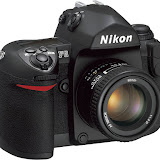The Nikon F6
Handling
The F6 handles very similar to the D300. Without the add-on grip, it
is similar to the D300 in size, but feels heavier. The grip is thicker,
and with my fingers, is a better fit than the D300.
From a size perspective, without the grip its height is similar to
that of F100. Due to its weight and metal back, it feels more solid in
the hand. With the MB-40 battery pack attached, the F6 has the same
height as the F3 with the MD-4 motor drive. I am very fond of the
F3/MD-4 combination, which I think feels superb in the hand. The F6 is
better in that the fingers naturally fall on the dials which allow the
shutter speed/aperture to be changed without having to move your hand
from the grip. With the F3, the shutter dial is further away, and to
change speeds, you have to take your hands off the grip.
How quiet is quiet?
Nikon makes a lot of noise in its sales literature about how quiet the F6 is. Compared to a film SLR
it is quieter, and the film advance is nearly silent. But overall it
sounds very much like the D300. I assume that all the refinement in the
F6 made its way into the D3/D300 cameras, therefore, for anyone used to
these cameras, the F6 sounds similar. The quiet advance mode seems to
increase the shutter lag slightly, perhaps to further reduce the sound.
The F6 is much quieter than the F100. It is significantly more
quieter than the older generation cameras, such as the F3. The F3 with
its motor drive makes a loud noise when winding film, like a gun firing.
But the F6 film winding is nearly silent. The only sound is that of the
mirror flapping and the shutter firing, just like the D300.
The mirror slap still has the SLR type ker-chunk sound – as opposed
to a rangefinder like Leica M6 which just goes click. The M6 shutter is
quieter than the F6 at medium/high speeds. Slower speeds in the M6 make a
whirring noise, typical of mechanical cameras. The manual winding of
the M6 is actually louder than the automatic film winding (in silent
mode) on the F6.
F6 Focusing screen
The focusing screen F6 appears to be superior to those in other cameras like the F100 or the D300. Its
focusing screen seems better designed for manual focusing; the focus plane transitions appear more clearly.
This is confirmed by an article on the Zeiss website that states that the focusing screens in Nikon D2, D3
series and F6 are well suited for manual focusing.
